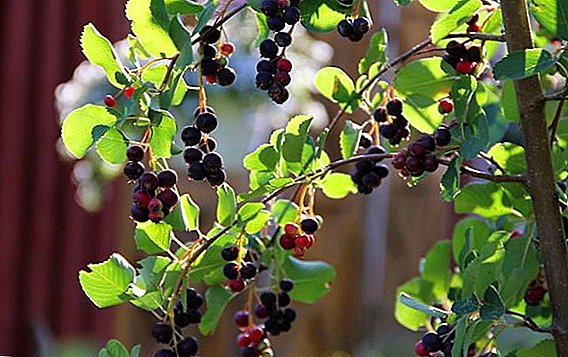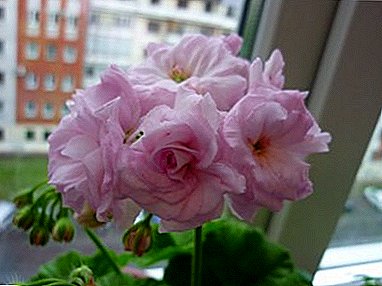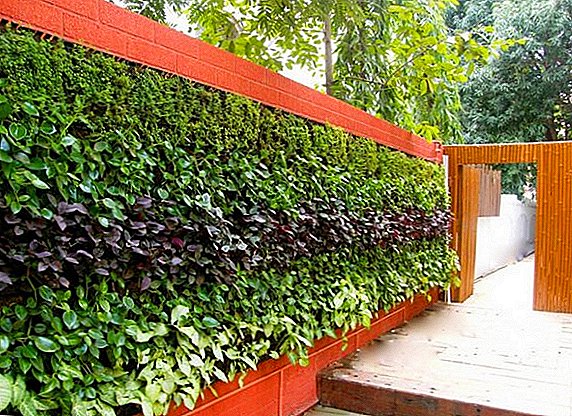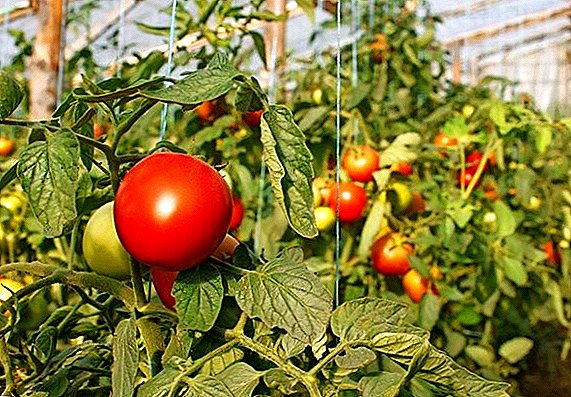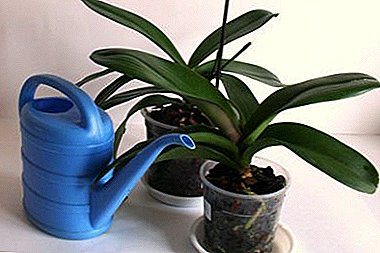
The orchid belongs to the orchid family, it is beautiful and easily recognizable by the unusual structure of the flower.
The birthplace of a beautiful orchid plant is tropics and subtropics, which is why it is very moisture-loving, but rather picky, and it will not be easy for beginning flower growers to grow a healthy and beautiful flower. It is necessary to adhere to the recommendations of experienced flower growers, and one of them is the correct watering.
Nutritious top dressings and ways of moistening
Watering orchids need only soft water as the soil dries. In the period of active growing season, watering should be abundant, and in the period of rest - moderate. The frequency of watering also depends on the air temperature in the room, humidity, size of the pot, type of soil, and the variety of the orchid itself.
Together with irrigation, you can simultaneously feed the plant with nutrients:
- So, acidify the substrate can be coffee or tea.
- A lot of potassium is contained in onion peel. It is necessary to grind, boil, insist well and cool. Water, diluted with water.
- Use also filtered water after boiling potatoes, it contains potassium.
- You can feed the infused wood bark, but a very weak solution.
- Many people use for the rare irrigation water from the washed meat with blood, diluted manure, but still it is better not to do this, because there is a big risk of infecting the orchid with dangerous microorganisms.
You can not water the flowers with running tap water, as it is often hard and contains many different harmful impurities.
There are several types of watering orchids:
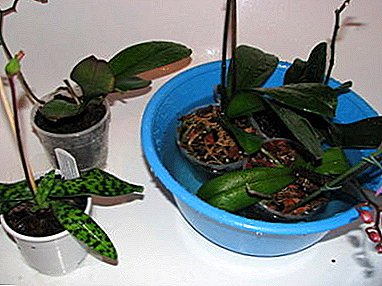 Watering can Water is poured in a thin stream on the ground, trying not to fall on the leaves. But there is one drawback - the roots drink water unevenly.
Watering can Water is poured in a thin stream on the ground, trying not to fall on the leaves. But there is one drawback - the roots drink water unevenly.- Immersion method A pot with an orchid is completely placed in separated water at room temperature. You can leave for 10 minutes, then drain the excess water.
- Watering in the pan. Plants are in a high tray, where a watering can is poured water. Minus - one diseased plant through the water can infect everyone else.
- Watering in individual pots. Water is also poured into the pan, but not common, but separately for each flower. Orchid takes the amount of water it needs. How to water an orchid in a pot or a pot is detailed here.
- Hot shower. Plants are watered with fairly warm water with a shower jet ("natural tropical rain"). This method is only suitable for regions with soft tap water, otherwise it will not bring benefits.
- Spraying roots. Used for orchids growing without soil on blocks. The roots are sprayed from a spray bottle.
How to water an orchid growing at home is written in a separate article.
How to feed a plant to make it blue?
How to process an orchid so that it turns blue? Need to remember! Blue orchids do not exist! If such a product is sold in a store, then it is most likely white, just painted with a chemical dye, which will eventually wash off.
For the first time blue phalaenopsis was presented at an exhibition in the USA in 2011. Then a few months later in Holland, the well-known kennel "Geest Orchideeën" presented the public to the Royal Blue Phalaenopsis (Phalaenopsis Royal Blue), painted using patented technology.
This dye is natural and does not harm the plant. The secret of this technology has not been disclosed. But many sellers, wanting to earn good money and not caring about the health of an orchid, try to paint it in the desired color without any technology. Most often these are just injections of ink or blue ink in the stem or root of a plant. After buying an orchid may simply die.
Breeders in Japan have brought out the only truly blue orchid species by introducing the blue-eyed gene, but unfortunately it is not for sale.
If you still really want to try to "paint", it is better to use food dyes. Paint to dissolve in water for irrigation. The richer the color of the water, the brighter the color of the plant. The procedure is simple, but not very effective and not durable.
If you stop watering the dye, the former color of the orchid will return. Florists recommend to use water in which aluminum alum was soaked for safe coloring. The injection is more effective, but the damage to the plant is enormous. Most likely it will get sick and will require constant care.
What water should I use?
 For irrigation of orchids, soft, separated tap water, as well as boiled, rain, distilled water, and melted snow are used.
For irrigation of orchids, soft, separated tap water, as well as boiled, rain, distilled water, and melted snow are used.
Rainwater collected in the city and melting snow will not benefit the plants. due to the high content of gases and dust. Country snow and rainwater are stored in a cold place.
If there is no water, you can boil tap water to make it softer and remove bacteria. Also suitable water filtration method. Oxalic acid helps to soften the water. A high acidity can be removed with a few drops of lemon juice.
Distilled water is considered dead, it does not contain salts, so it is diluted with tap water: if the water is very hard, then one part of the water from the tap is taken 2 parts distilled, with an average hardness - one to one.
Any water advised to enrich with oxygen, pouring it before watering from one dish to another.
Can I use supplements?
Hydrogen peroxide
Hydrogen peroxide in small amounts accelerates the blooming of the orchid and its growth, eliminates bacteria and pests, saturates the soil with oxygen, prevents the roots from rotting, strengthens them.
Most often, peroxide is used for disinfection and as fertilizer in the period of illness., various plant damage. First, dry leaves and rotten flowers are removed from the orchid, loosening the ground. Then pour a solution of hydrogen peroxide (30 ml per full glass of water).
Potassium permanganate
Manganese is involved in photosynthesis of plants, and its deficiency (in alkaline soils) or excess (in acidic) is bad for the well-being of orchids, chlorosis begins. But if you use a properly selected soil (pH 5, 5 - 6, 5) this should not be.
To do this, warm water is poured into a glass container and several particles of manganese are placed there with the help of a toothpick. Stir until complete dissolution, so as not to burn the plant. Then mix the solution with distilled water to the desired concentration.
Yeast
 Yeast is a good fertilizer for orchids that affect their growth.help to cope with diseases and some pests.
Yeast is a good fertilizer for orchids that affect their growth.help to cope with diseases and some pests.
The solution is prepared at the rate of 1 gram of dry yeast per liter of water and insist one day.
It is possible to water with a solution both orchids, and to spray. It is also advised to add a teaspoon of sugar or a few drops of valerian for a stronger effect from top dressing.
Cytokinin paste
Cytokinin paste is, first of all, phytohormones that promote the growth of shoots and buds. It is applied with a needle on the kidney and after about ten days an escape appears from it.
The paste also helps to “raise” the perishing orchid. But you need to use it in very small quantities.
Ammonia
Calcium is used for orchids as a fertilizer and as protection against some pests (ticks, midges), but with it you must be very careful not to burn the roots and poison the plant. Therefore, the solution should be minimally concentrated (preferably 10%).
It must be remembered that all these substances are beneficial only in small doses. Concentrated solutions can damage the orchid even more and even lead to death.
Fitolavin
Fitolavin is a systemic antibiotic and treats plants mainly for rot. It is a fairly safe and effective means for the prevention of disease, and in the early stages of flower disease.
For orchids, phytolavin is often used for vascular wilt. Preparing the solution is quite simple: 2 ml of antibiotic for 1 l of water. It is necessary to spray only with freshly prepared solution.
What are the results of improper watering?
 Improper watering can lead to the death of orchids. Although this plant and moisture-loving, it is still better underfilling than overflow. Otherwise, the roots just rot. Indeed, in nature, orchids grow on stones and tree branches.
Improper watering can lead to the death of orchids. Although this plant and moisture-loving, it is still better underfilling than overflow. Otherwise, the roots just rot. Indeed, in nature, orchids grow on stones and tree branches.
We can not allow stagnation of water in the pan and in a pot of orchids. This will lead to rotting of the roots and death of the plant.
When there is an excess of moisture on the leaves, swelling appears, which are not amenable to treatment, they only need to be deleted.
We must not forget that the orchid is a capricious plant, and proper watering is one of the important conditions for its health. With the observance of simple rules, an orchid will still delight with its flowering.
How to fix errors?
If the overflow did occur, the leaves wrinkled, and the flowers or buds disappeared, it is necessary to transplant the orchid. In no case can you dry the flooded orchid near the heating devices or other sources of heat.
- You need to get the flower out of the pot, without damaging the roots, clean the ground from them and soak in water for 15 minutes.
- Then let dry and examine each spine.
- Remove all sodden or diseased fungus with shears and treat the cut areas with charcoal.
- New sanitize pot and transplant without tamping the ground.
If almost all the roots have died, then you can not immediately transplant. The orchid should be placed in a plastic jar of water so that its remaining roots almost touch the water. Water maintained at this level, and the plant sprayed. When the roots reach at least 5 cm, you can transplant (how to water the plant after transplantation?).
Practice shows that One of the main causes of the death of orchids is improper watering. Therefore, in order to avoid mistakes, especially for beginner growers, you must first study how the orchid grows in nature, how it feeds, and, starting from this knowledge, try to recreate the natural conditions to it as much as possible.


 Watering can Water is poured in a thin stream on the ground, trying not to fall on the leaves. But there is one drawback - the roots drink water unevenly.
Watering can Water is poured in a thin stream on the ground, trying not to fall on the leaves. But there is one drawback - the roots drink water unevenly.